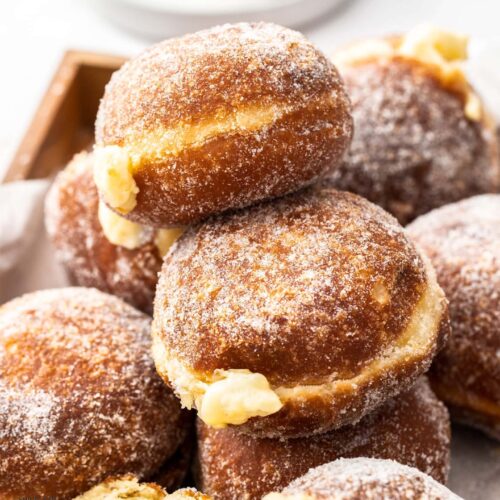If you’re looking for a fun and delicious donut recipe, look no further than these Bavarian donuts. Silky pastry cream filled pillows of dough.
- Soft, fluffy and filled with flavour.
- Rich, creamy vanilla filling.
- Proofed overnight which creates amazing flavour and allows you to get ahead.
- Fun to make and it makes a great weekend project.
- While not the quickest treat to make, the steps are easy and the reward is like nothing else.
If you love fried doughnuts, you definitely need to try these caramel doughnuts filled with brown sugar custard or try them baked instead in these lemon donuts.
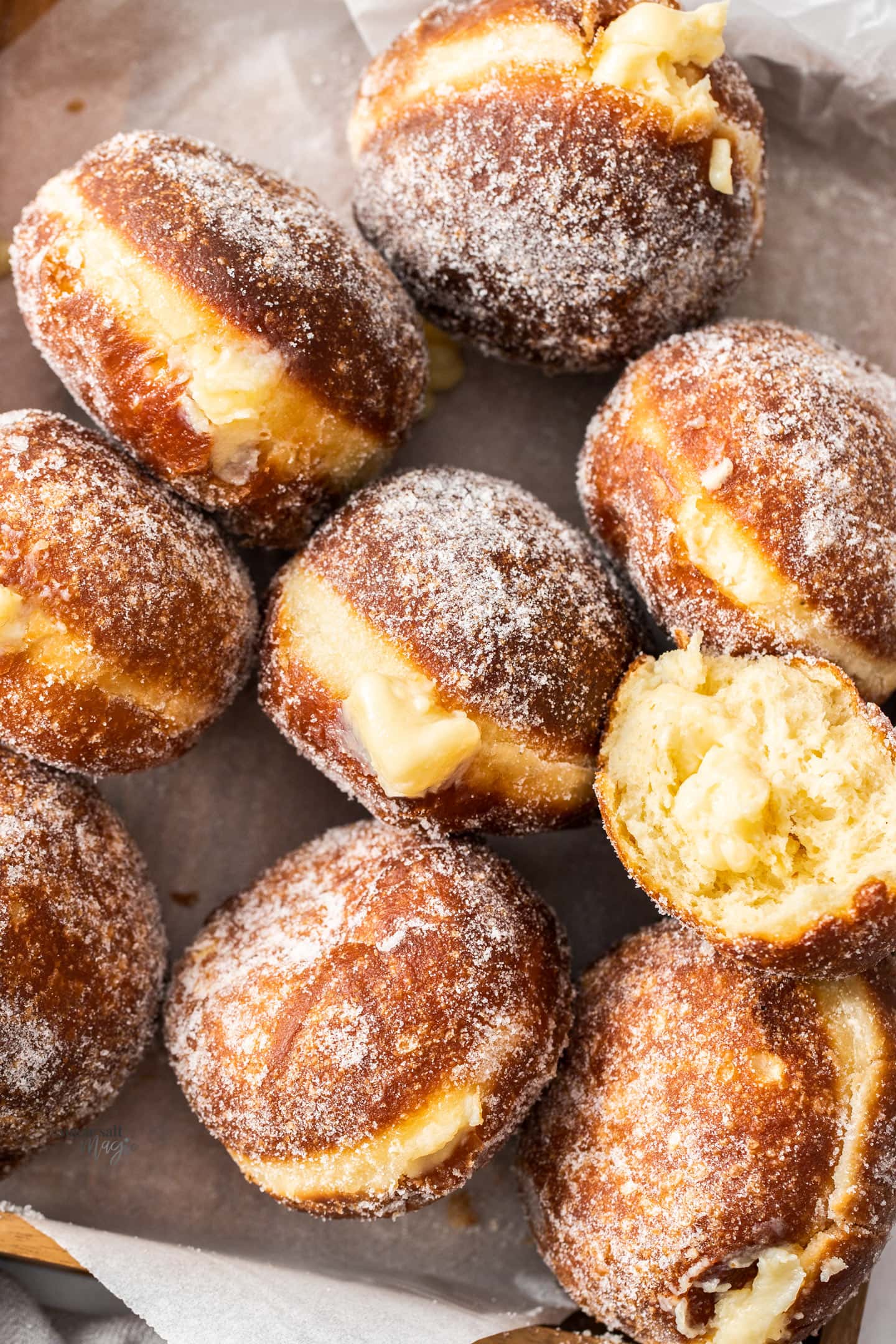
Table of contents
Never Miss a Recipe!
Get the latest recipes straight to your inbox!
While the recipe card gives you what you need to know to make this recipe, it’s worthwhile at least skimming the post. Here, you’ll find extra tips, FAQ’s, variations etc from my testing and research.
Ingredients in Bavarian donuts
Just 10 ingredients total which includes the fluffy donut and that rich pastry cream filling.
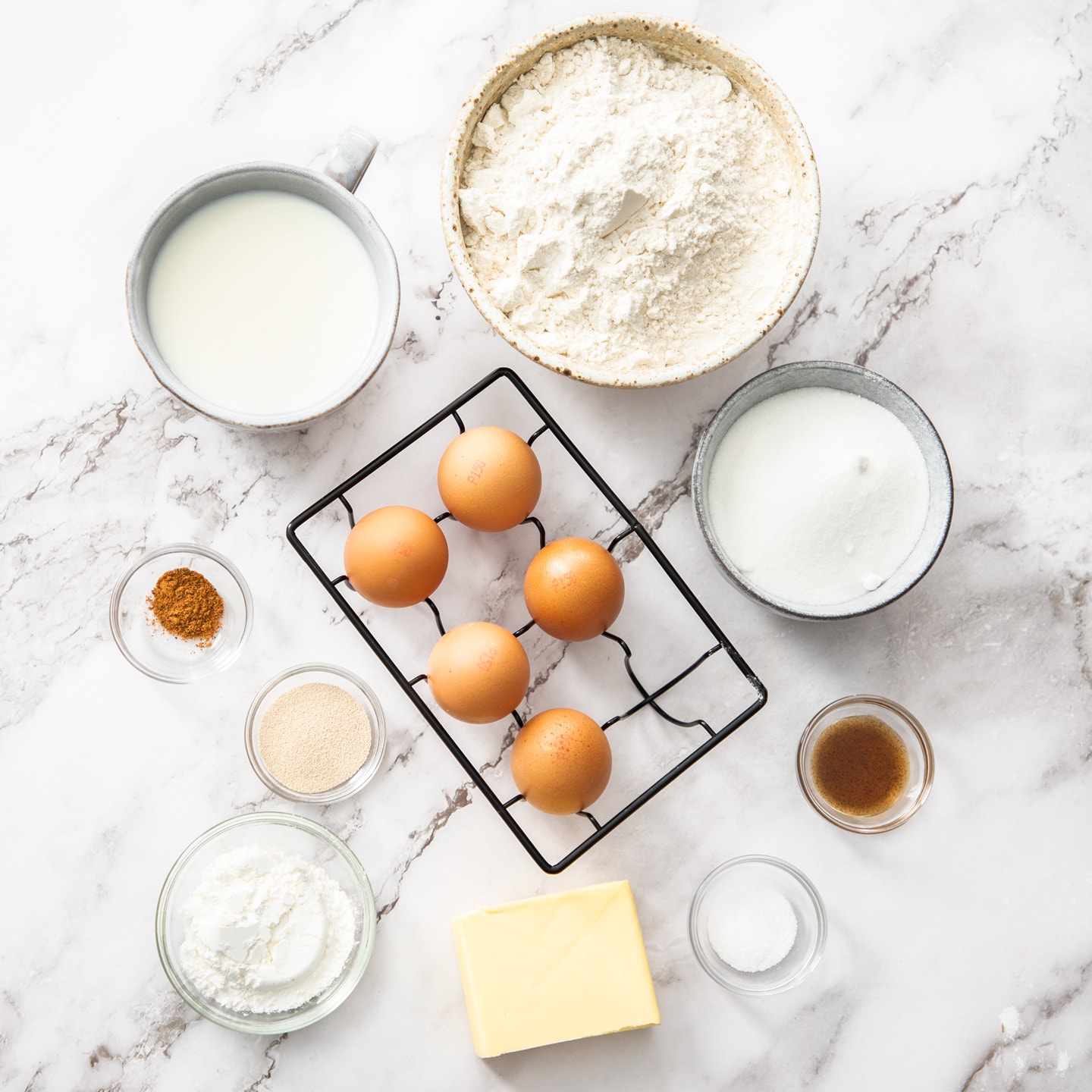
Detailed quantities and instructions in the recipe card below.
- Flour: I just use plain flour / all-purpose flour and it gives just enough chew but lots of softness. You can use bread flour if you want a chewier donut.
- Yeast: You’ll need instant dry yeast for this recipe. You can use active-dry yeast in the same quantity but make sure not to skip the first step.
- Sugar: You’ll just need one sugar for this – caster sugar (aka superfine sugar). This is not powdered sugar. It’s just finer granulated white sugar and you can grind regular white sugar to make it finer.
- Salt: Just a little salt intensifies flavours.
- Milk: Use full-fat milk which will give the best flavour and texture.
- Eggs: I use large free-range eggs.
- Butter: As this is an enriched dough, meaning it has added fat, we use butter for that richness. Use unsalted butter.
- Nutmeg: Just a little nutmeg adds a little cosiness that donuts always benefit from.
- Vanilla: Please use vanilla paste or pure vanilla extract. Don’t use essence, which is a synthetic flavouring.
- Cornflour / cornstarch: Cornflour (aka cornstarch in some parts of the world) is a thickening agent. It’s a very fine type of flour and is used here to thicken the filling.
Tools required
- Stand mixer: I recommend using a stand mixer with a dough attachment to make the dough. It takes slightly less time than by hand but more importantly is much less effort. If you feel like a workout though, you can certainly prepare and knead this dough by hand though it could take upwards of 20 minutes.
- Mixing bowl
- Saucepan for making the vanilla cream filling.
- Slotted spoon for turning and removing the doughnuts from the oil.
- Piping bag with cream puff piping nozzle. The nozzle is not absolutely necessary but just makes it easier to get the tip of the piping bag into the doughnut.
How to make Bavarian cream donuts (step-by-step)
Detailed quantities and instructions in the recipe card below.
Making the donut dough
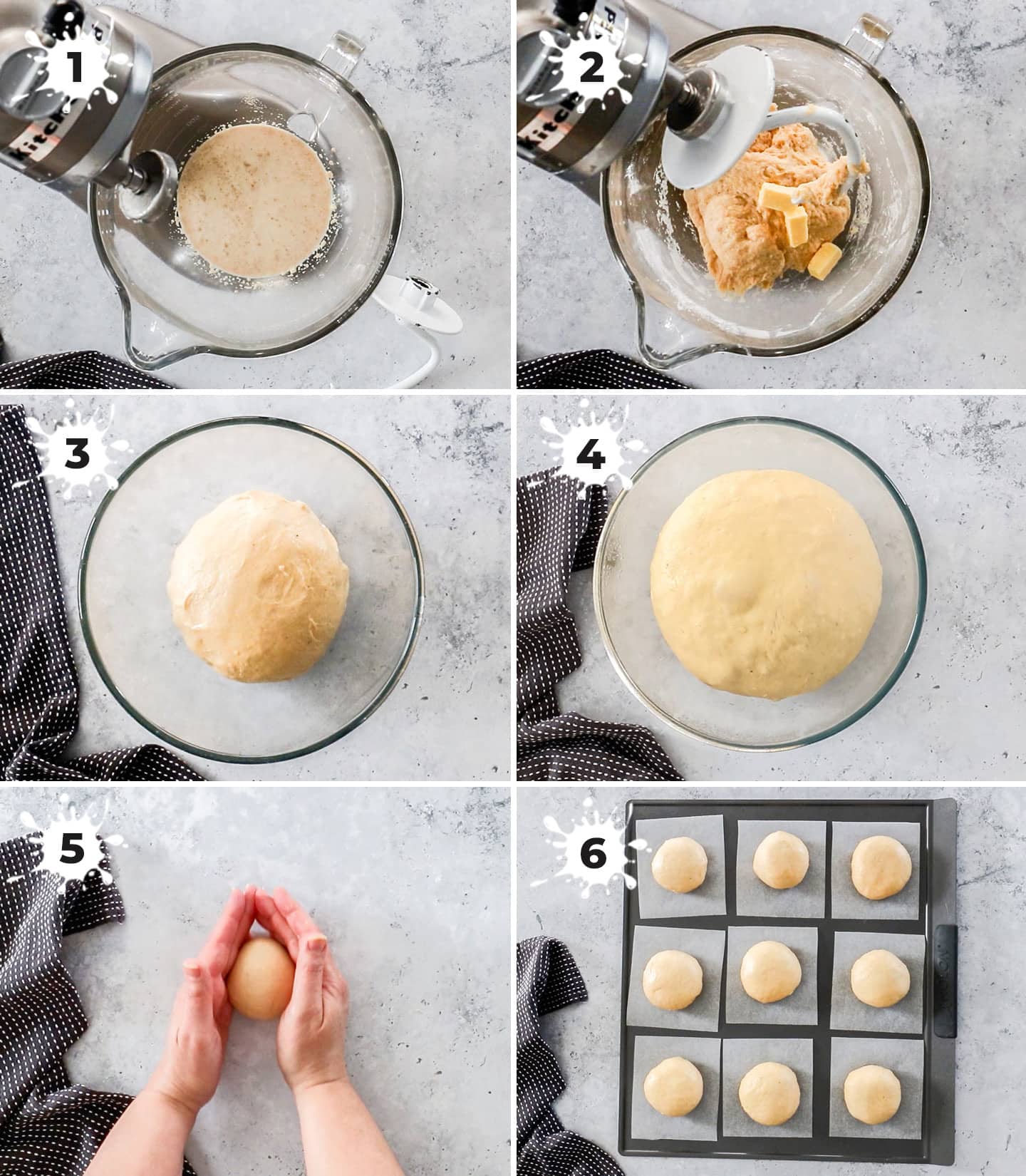
- Activate the yeast: First, we’ll start by activating the yeast. You just need to mix the yeast into some sugar and warm milk and then give it 10 minutes to sit. If it’s active / alive, it will get frothy on top (photo 1).
- Turn it into a dough: Now add the dry ingredients – flour, salt, nutmeg- and the eggs and an additional egg yolk to the yeast mixture. Use a stand mixer with a dough hook, if you have one, to mix this until combined into a rough dough. Knead this on low for another 3 minutes. This allows the dough to start developing gluten which gives the doughnuts that classic chewy texture.
- Add the butter: Now add the butter a little at a time (photo 2) letting it mix in before adding more. Once it’s all added, continue kneading the dough for a further 5-10 minutes on low until it’s looking smooth and elastic. It’ll be soft but should be pulling away from the bowl and feel pillowy and plump.
- Rest the dough: Place the dough into an oiled bowl (photo 3), flip it to coat in oil, then cover with plastic wrap. Chill in the fridge overnight from 12-24 hours.
Turn the dough into donuts
- The next day (photo 4), take the dough out of the bowl, and give it a quick knead. Now weigh it and divide the total weight by 9. I normally get 9 dough balls around 100g / 3.5oz each.
- Shape them: Give each ball of dough a light knead then gradually pull in the sides pinch them underneath until the top is smooth and almost round. Now place the ball down onto your work surface, cup it with your hands on each side and gently drag it toward you 3-4 times until you have a perfectly round ball (photo 5).
- Rest and proof: Place it pinched side down onto a square of baking paper on a baking sheet and repeat with the rest (photo 6). Set the dough balls aside under a light tea towel to rise for 1 ½-2 hours or until doubled in size.
Make the Bavarian cream filling
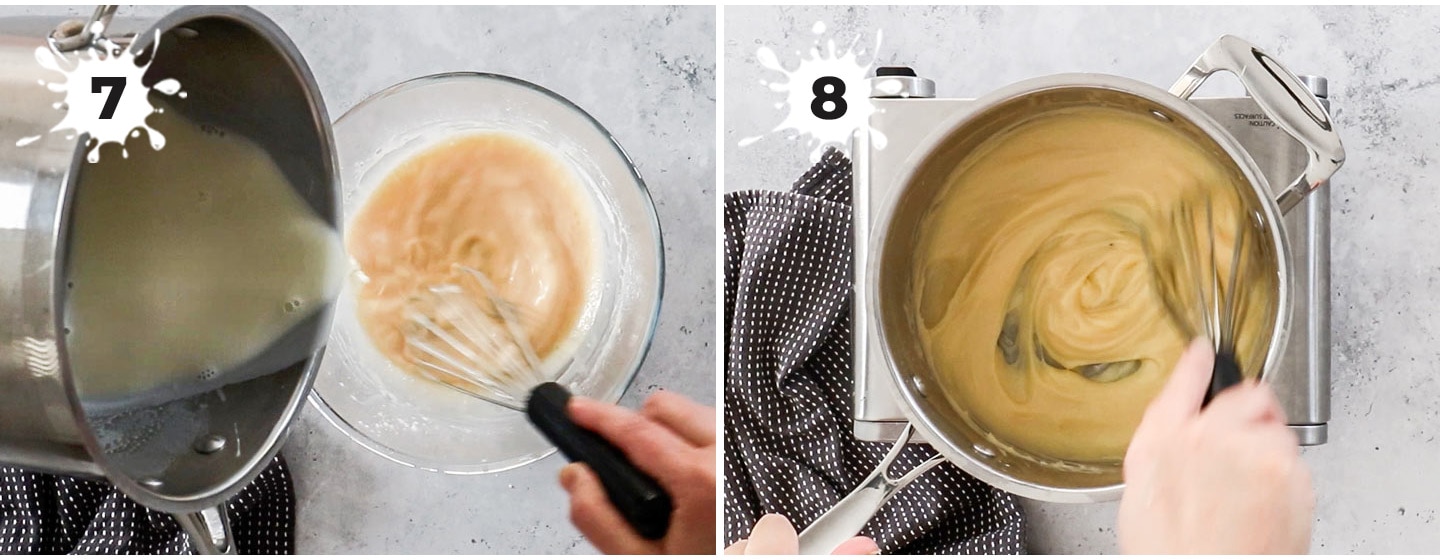
The Bavarian cream filling is actually crème patissiere, also know as pastry cream. It’s a thick, rich and smooth vanilla custard that melts in your mouth. It’s very easy to make, just take care not to heat it over too high a heat and keep stirring or it may end up lumpy. If you want a lighter filling, you can make a diplomat cream simply by adding some whipped cream to the crème patissiere.
- Make the custard mixture: Heat milk, sugar and vanilla together until steaming. In a medium mixing bowl, whisk together a little more milk, egg yolks and cornflour. Slowly drizzle the hot milk mixture into the egg mixture while whisking (photo 7) until combined.
- Cook the custard / crème patissiere: Return everything to the saucepan and whisk until it gets really thick and the pastry cream no longer settles back into itself (photo 8). Pour it into a dish and press plastic wrap to the surface. Let it cool completely at room temperature.
Cook the Bavarian donuts
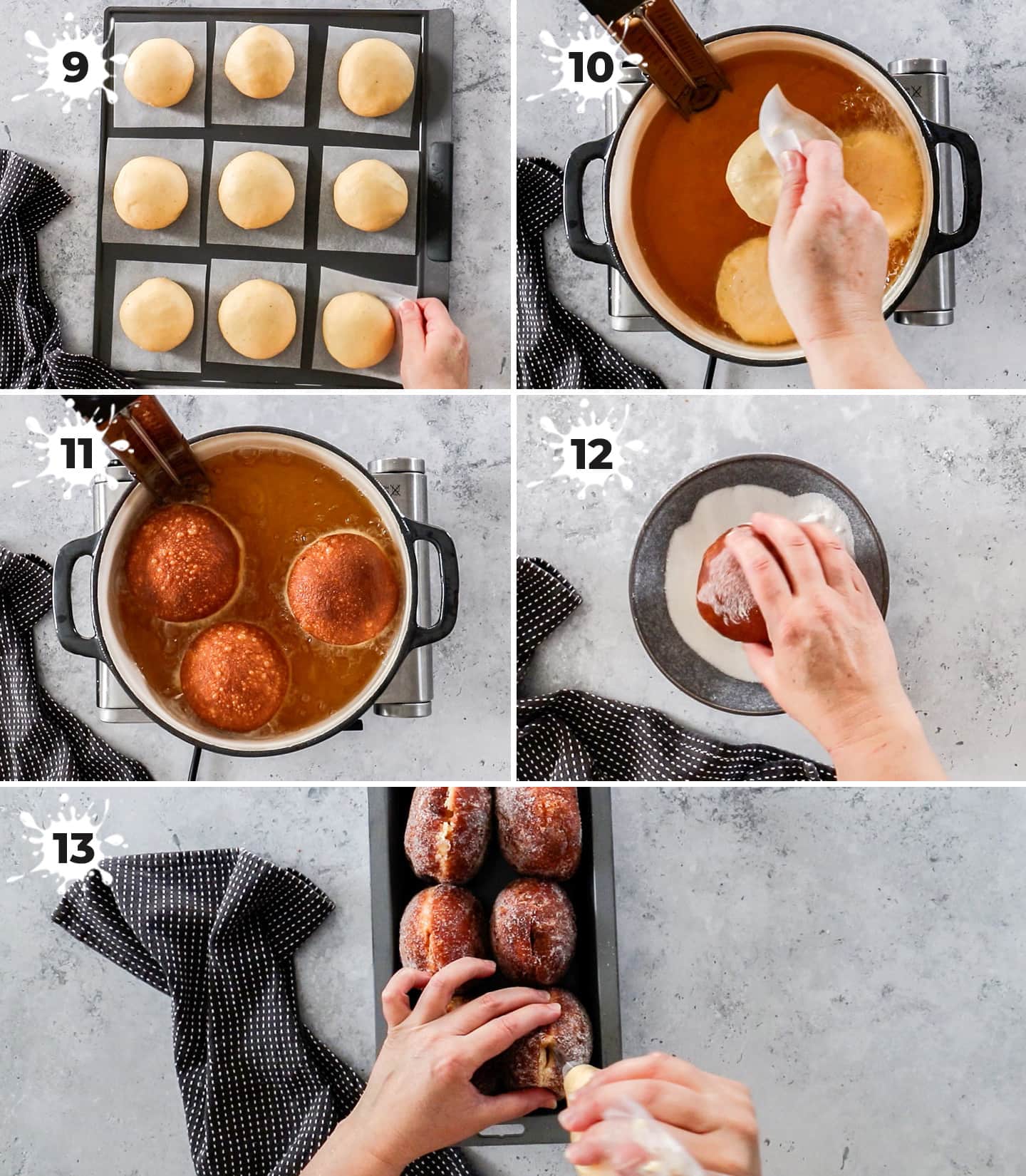
- Once the dough balls have proved again and doubled in size (photo 9), heat 2 litres (2 quarts) of vegetable oil in a dutch oven or large saucepan until it reaches 180C / 350F. A candy or deep frying thermometer is essential here so that you can keep an eye on the temperature.
- Add 2-3 donuts to the hot oil at a time – don’t overcrowd the pan . Hold the baking paper with your dominant hand and hold the dough with your other hand. Gently place it into the oil and peel the paper away (photo 10). Be very careful not to drop it from a height or you’ll splash yourself with hot oil.
- Cook the doughnuts for 3-4 minutes until golden brown underneath (keeping an eye on the oil temperature regularly and adjusting the heat as required) then gently turn them over (photo 11) and cook for a further 3-4 minutes.
- Transfer the cooked doughnuts to a baking tray covered with paper towels to drain for 30-40 seconds. Roll them in caster sugar to coat (photo 12) while still hot then set aside to cool completely. Once the doughnuts are completely cooled, fill the centres with the cream filling.
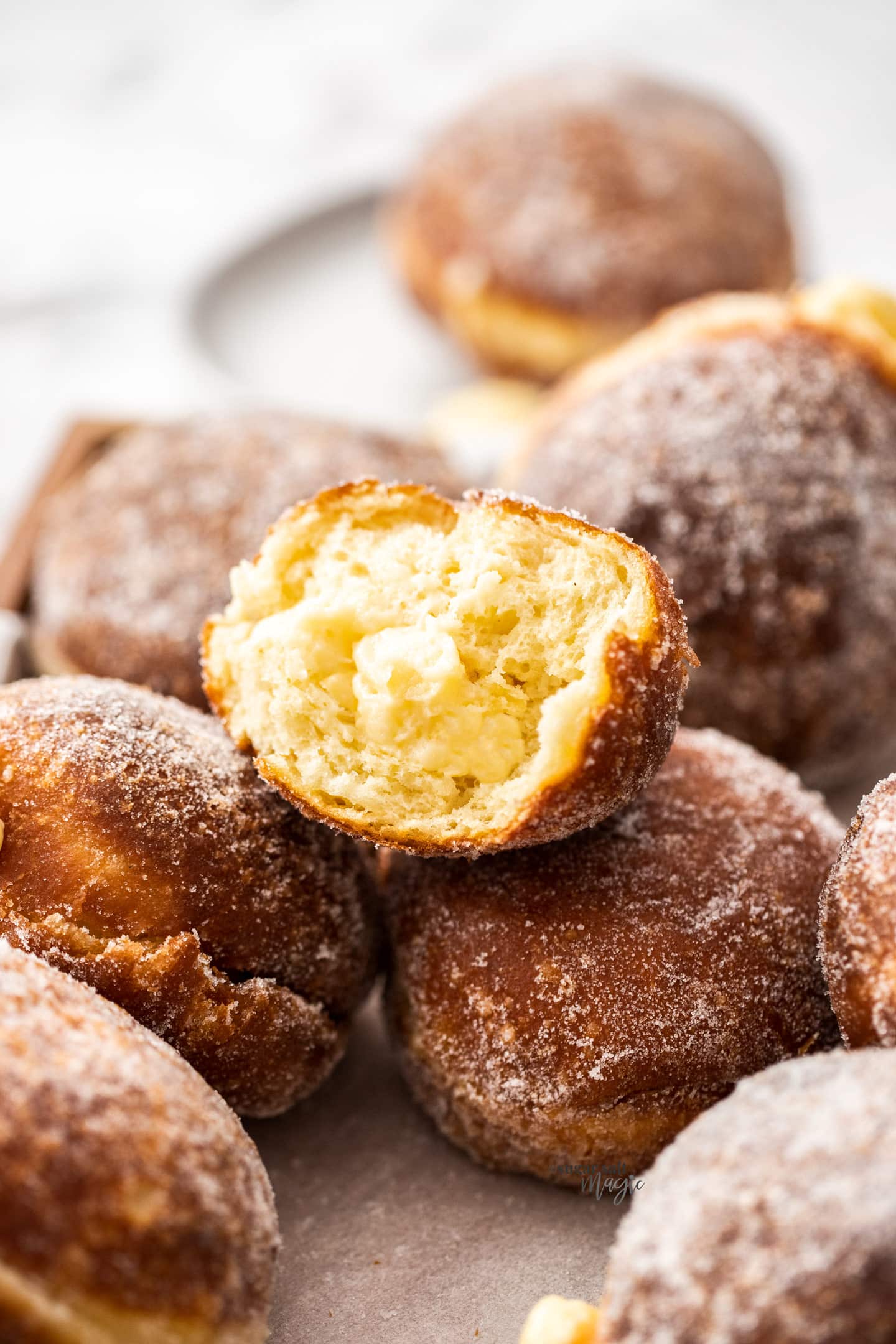
Tips and tricks
- Weigh the flour: It’s especially important when making doughs or baking cakes, that you weigh the flour with kitchen scales. A little too much or too little will totally change the texture of your recipe. I add cup measurements for convenience, however, if you must use cups, please make sure to spoon the flour into your cup, then use the back of a knife to level it off.
- Don’t be tempted to add more flour: This dough should remain soft and just a little sticky but it will be manageable. The kneading process develops gluten which will help the dough to become less sticky so just be patient and let it come together naturally. Adding more flour will only make your doughnuts dry and dense.
- Activating the yeast: Technically, this step is not required with instant yeast, however it is required for active dry yeast. The reason I always take this step, even with instant yeast, is to make sure the yeast is alive. If I were to put it straight into the dough, there is potential to waste a lot of time and ingredients if it turns out the yeast is no good.
- Don’t overheat the milk or it will kill the yeast.
- Shaping the doughnuts: Shape the dough first in your hand. Hold it in the palm of your non-dominant hand. Use the fingers of your dominant hand to pull and pinch in the dough which will smooth out the side against your palm. Now place the dough ball down onto your work surface and cup it with a hand on either side. Carefully drag it, against the work surface, towards you. Turn 90° and repeat. Do this 3-4 times until you have a nice smooth ball.
- Heat the pastry cream filling gently: Make sure to only heat the pastry cream over low-medium heat and whisk constantly so that you don’t get a lumpy filling.
- When cooking with hot oil be extremely careful. Don’t drop the doughnuts in from a height. Lower them to the surface. If you don’t want your hand to get too close, use some tongs or the slotted spoon to help.
- Don’t overcrowd the pan: The doughnuts need a little space so they can puff up nice and big. Also, the more dough balls you add to the pan the more the temperature of the oil will drop.
- Use a slotted spoon to remove the donuts from the oil: A slotted spoon will allow the oil to drain away from the donuts.
- Piping the pastry cream: I use a cream puff nozzle which is a long thin piping nozzle that allows you to push it into the centre of the doughnut. As you pipe, you will feel it pushing back out. Let it do that and you will have filled it.
- Use all the pastry cream: To make sure you get plenty of filling in the doughnuts make sure to use all the filling.
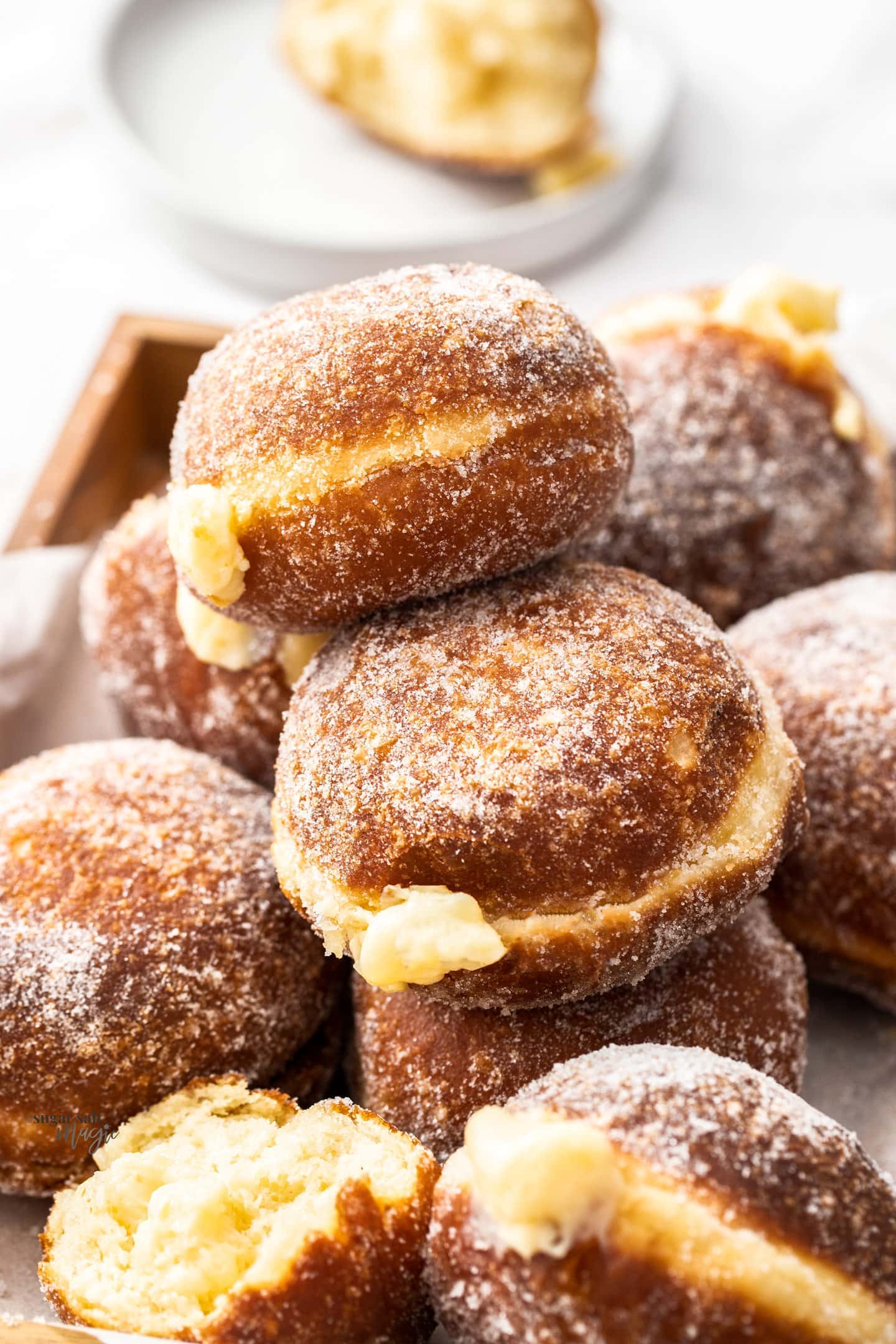
How to check doughnuts are cooked
The last thing you want is to bite into your Bavarian doughnut only to find a big uncooked, doughy blob in the middle. Make sure the oil is staying around the 180C / 350F mark. If it dips too low, they won’t cook in the same time. If it gets too high, they will cook quicker.
Sacrifice the first cooked one and cut into it to see if the middle is cooked. From this you’ll be able to determine the cooking time you need.
Variations
You can use this chocolate pastry cream recipe instead of the vanilla if you prefer. You can also fill your doughnuts with your favourite jam instead.
Yield and storage
I’ve written this recipe to create 9 regular doughnuts. You can make them a little smaller to get 12-13 out of the recipe, however they won’t take so long to cook. You might be looking at more of a 2-3 minute cook.
Bavarian cream donuts like all fried donuts are best eaten very fresh. Serve them as soon as they are filled. If you do have leftovers, just give them a little zap in the microwave (like 8-10 seconds) just to fluff them up without heating up the pastry cream. Store the leftovers in an airtight container in the fridge for 1-2 days, maximum.
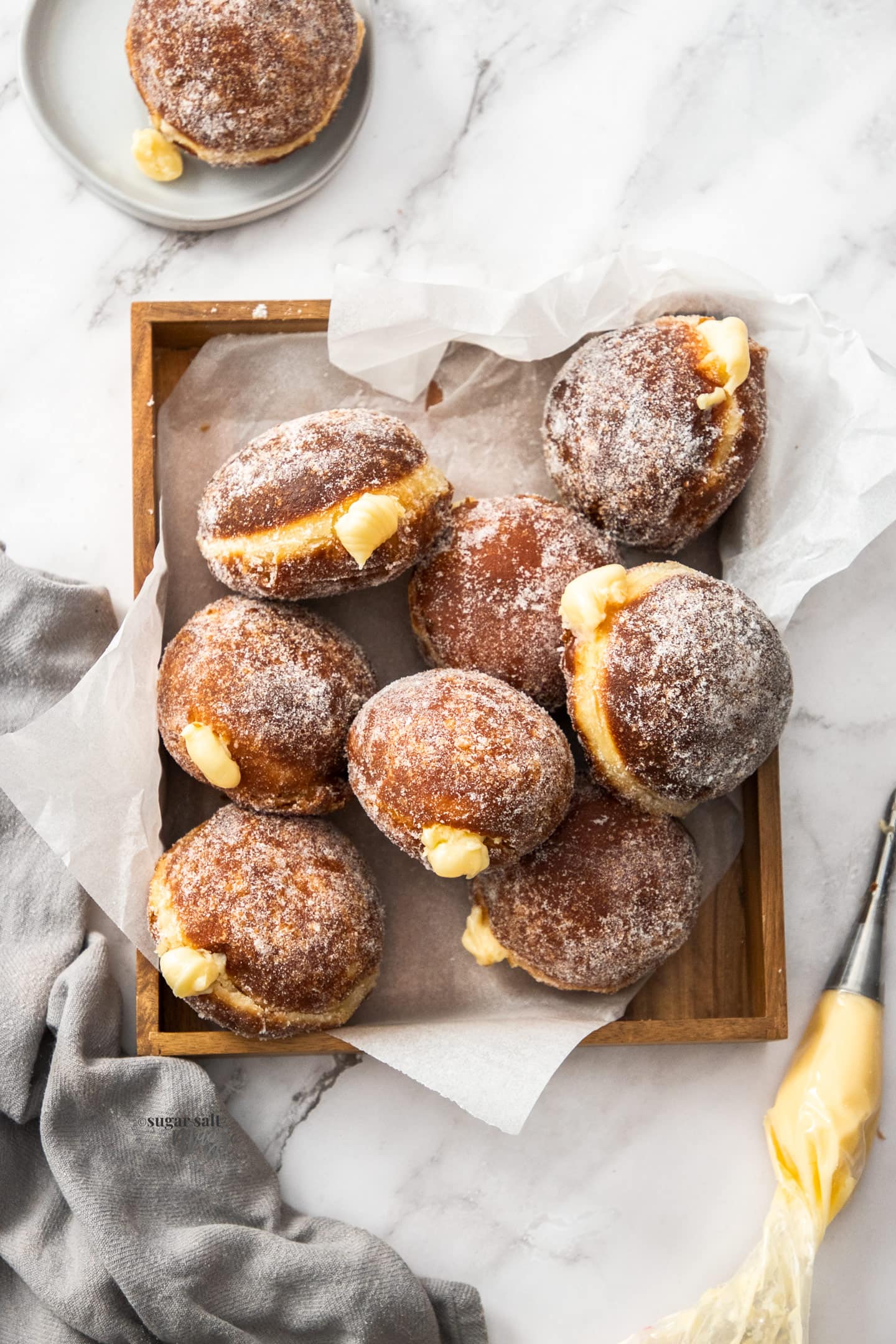
More recipes you’ll love
- Lemon donuts (classic donuts but baked, not fried)
- Jam doughnuts (classic donuts but baked, not fried)
- Caramel doughnuts with brown sugar custard (classic fried doughnuts)
- Chocolate chouxnuts (doughnuts mad with choux pastry)
- Biscoff donuts (cake style donuts)
- Cinnamon caramel cake donuts (cake style donuts)
- Orange donuts with pomegranate icing (cake style donuts)
- Maritozzi (Italian cream buns) – brioche style bun filled with vanilla cream
Did you try this Bavarian cream donuts recipe?
Leaving a rating and comment below the recipe is so helpful!
Hungry for more? Subscribe to the newsletter for free recipes straight to your inbox. Also, follow along on Facebook, Pinterest and Instagram.

Ingredients
FOR THE DOUGHNUTS
- ¾ cup milk
- ¼ cup white sugar (50g / 1.8oz)
- 2 ¼ teaspoons instant yeast (or active dry – notes 1) (7g or 1 sachet)
- 450 g plain flour (all-purpose flour) (3 ½ cups / 1lb)
- ½ teaspoon salt
- ¼ teaspoon freshly ground nutmeg
- 2 large eggs
- 1 egg yolk, from a large egg
- 113 g unsalted butter, softened (1 stick / ½ cup)
- 2 litre vegetable oil (like canola / sunflower / rice bran)
- 1 cup caster sugar (superfine sugar), for coating (200g / 7oz)
FOR THE PASTRY CREAM
- 1 ½ cups whole milk (375ml)
- ⅓ cup caster sugar (superfine sugar) (66g / 2.3oz)
- 1 teaspoon pure vanilla extract
- ¼ cup cornflour (cornstarch) (30g / 1oz)
- 2 egg yolks from large eggs
For best results, always weigh ingredients where a weight is provided
Equipment
- Stand mixer (recommended)
- Saucepan
- Slotted spoon
- Piping bag with cream puff piping nozzle (recommended)
Instructions
- FOR THE DOUGHNUT DOUGH: Warm the milk for about 15 seconds in the microwave. You don’t want it to be hot, just slightly warmer than room temp. Pour the milk into the bowl of a stand mixer with the sugar then sprinkle the yeast on top and stir it around. Let it sit for 5-10 minutes until frothy.
- Add the flour, salt, nutmeg, eggs and egg yolk. Beat with a dough hook on low speed for for 4-5 minutes until starting to smooth out.
- With the stand mixer, with a dough hook attachment, on low-medium add the butter a couple of cubes at a time letting it mix until it is all fully incorporated. This takes a little time but be patient.
- Once all the butter is incorporated, knead on low for a further 5-10 minutes. When done, it will be smooth, soft and elastic and pulling away from the sides of the bowl.
- Grease a large bowl with a tiny bit of oil or oil spray. Place the doughnut dough into the bowl and flip to coat. Cover tightly with plastic wrap and sit in the fridge overnight for 12 or up to a maximum of 24 hours.
- SHAPE THE DOUGHNUTS: Take the dough out of the bowl and give it 3-4 quick kneads. Weigh the dough (this helps to get even sized doughnuts which in turn helps them cook evenly). Whatever the total weight is, divide it by 9 to make 9 doughnuts (mine are normally close to 100g / 3.5oz each).
- Once you have your 9 pieces of dough, start by holding it in one hand and with the other, pull and pinch the dough from the edges towards the centre until the part in your palm is fairly smooth.
- Place the ball pinched side down on your work surface. Cup it either side with your hands and gently drag it towards you against the work surface. Turn it 90° and repeat another 2-3 times until you have a nice smooth little ball.
- Cut 9 small squares of baking paper and place each of your dough balls onto one of the squares of paper on a baking tray. Cover with a light tea towel and let them rise until doubled in size – 1 1/2 – 2 hours.
- Go on with the pastry cream.
- FOR THE PASTRY CREAM: Pour 1 ¼ cups of milk into a heavy based saucepan, and add sugar and vanilla, then heat on low-medium heat until steaming, stirring regularly to dissolve the sugar. Remove from heat.
- In a large bowl, whisk together the remaining ¼ cup milk, egg yolks and cornflour until smooth and fully combined.
- While whisking, very slowly pour the hot milk mixture into the egg mixture in a slow but steady stream. Don’t pour it too quickly or the heat will scramble the eggs.
- Once everything is combined, return the mix to the saucepan. Heat over low-medium heat, stirring with a whisk constantly, until it gets very thick and no longer settles into itself when you move it around. This will happen quite quickly after about 5 minutes so it’s important to keep gently whisking increasing intensity as it gets very thick. You will end up with lumpy custard if you don’t.
- Swap to a silicone spatula and pass the custard through a strainer into a clean bowl, then press plastic wrap to the surface and allow to cool to room temperature.
- TO COOK THE DOUGHNUTS: Lay out a couple of layers of paper towel on a plate or tray. Attach a candy thermometer to the side of a dutch oven or large saucepan and pour in the oil. Heat the oil to 180C / 350F.
- Once the oil is at temperature you can start adding the doughnuts. Cook in batches of 2-3 – don’t overcrowd the pan. To transfer the dough balls to the oil, hold the baking paper with one hand and gently hold the other side as you turn it over close to the oil – don’t drop it from a height or you will get splashed with hot oil. Once you have the doughnut in the oil, peel away the baking paper.
- Deep fry for 3-4 minutes and deep golden brown underneath. Flip over using a slotted spoon and fry the other side for 3-4 minutes. Always keep an eye on the temperature – if it drops too low they won’t cook through quickly enough and will become oily. If it goes too high they may cook too quickly and burn while the inside won’t be cooked.
- Remove them from the oil using a slotted spoon allowing the oil to drip off and transfer them to the paper towel for 30 seconds.
- Roll in the caster sugar (you need to do this while they’re still hot so that it sticks) then transfer to a wire rack to cool completely.
- Repeat with the remaining doughnuts making sure the oil is at the right temperature before starting.
- Once the doughnuts are cool, give the custard a good mix up to get it smooth, then transfer to a piping bag with a cream puff piping nozzle.
- Cut a small slit in the side of the donut and place the piping nozzle into the slit roughly to the centre. Gently squeeze in your filling until you feel the piping bag being pushed back. Gently pull out the piping nozzle but filling the doughnut right to the outside.
- Serve immediately. Best eaten the same day as they’re made.
- Please take a moment to leave a comment & rating. It's appreciated and so helpful.
Notes
- Activating the yeast: Technically, this step is not required with instant yeast, however it is required for active dry yeast. The reason I always take this step, even with instant yeast, is to make sure the yeast is alive. If I were to put it straight into the dough, there is potential to waste a lot of time and ingredients if it turns out the yeast is no good.
- Use scales: For best results, you should always weigh ingredients like flour and sugar. Kitchen scales are relatively cheap but if you can’t weigh the ingredients, use the spoon and level method (don’t scoop).
- Yield: This recipe yields 9 donuts but you can make them smaller. Keep in mind the cooking time will change depending on size. Test one from your first batch but cutting it open to see if the inside is cooked.
- Resting time: The extended resting time in this recipe gives both a more complex flavour and a better texture, though you can speed it up. Just make sure the dough rises to double it’s size on each resting period.
- Don’t be tempted to add more flour: This dough should remain soft and just a little sticky but it will be manageable. The kneading process develops gluten which will help the dough to become less sticky so just be patient and let it come together naturally. Adding more flour will only make your doughnuts dry and dense.
- When cooking with hot oil be extremely careful. Don’t drop the doughnuts in from a height. Lower them to the surface. If you don’t want your hand to get too close, use some tongs or the slotted spoon to help.
- Don’t overcrowd the pan: The doughnuts need a little space so they can puff up nice and big. Also, the more dough balls you add to the pan the more the temperature of the oil will drop.
This post may contain affiliate links that earn me a small commission for my referral, at no extra cost to you. Thank you for supporting Sugar Salt Magic.

